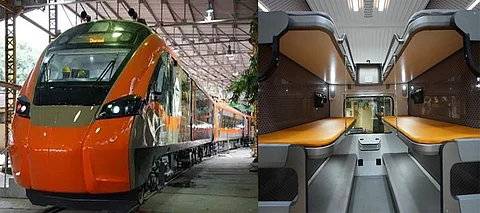

Indian Railways is poised for a revolution in long-distance rail travel with the impending introduction of the Vande Bharat Sleeper trains. The new semi-high-speed, long-distance electric multiple unit (EMU) trains are meant to take the place of the legendary Rajdhani Express and introduce world-class features, speed, and safety to overnight travel across India.
The Vande Bharat Sleeper train concept, formerly Train-20, was started to upgrade and accelerate long-distance travel in India, where travel exceeding 1,000 km generally takes over 12 hours. For instance, the Mumbai-New Delhi Rajdhani travels 1,386 km in over 15 hours. To mitigate this, Indian Railways started to upgrade tracks and design next-generation trainsets on the back of the highly successful Vande Bharat Express (formerly Train-18) used for short-distance routes.
Once the initial plans and tenders were reworked, the sleeper variant was renamed Vande Bharat Sleeper. The first prototype was rolled out in September 2024, with trial runs successfully conducted in January 2025.
First Launch: The initial Vande Bharat Sleeper train will start functioning by the end of July 2025.
Production orders: The Railways Ministry has placed nine more 16-car Vande Bharat Sleeper trains on production order with the Integral Coach Factory (ICF) in Chennai to be produced by December 2025.
Future expansion: Indian Railways has placed orders for the propulsion electrics for 50 rakes of 24-car Vande Bharat Sleeper trains, and complete-scale production of these longer variants is set to commence in 2026-27.
Speed: Design speed to 160 km/h, with a top tested speed of 180 km/h.
Capacity: The 16-coach train carries 1,128 passengers in AC 1st Class, AC 2-Tier, and AC 3-Tier coaches.
Amenities: Automatic doors, sleeper berth cushions, onboard Wi-Fi connectivity, USB charging points, improved HVAC systems, ergonomic toilets (with shower facilities in First Class), and real-time data black boxes.
Safety: With crash buffers, deformation tubes, fire barrier walls, Kavach (Train Collision Avoidance System), fire detection and suppression systems, anti-climbing provision, and HL3 safety standards compliance.
Comfort: The trains are built for a comfortable ride even at high speeds, as proven during trial runs when a glass of water didn't shake at 180 km/h.
Indian Railways has awarded large contracts to private and foreign parties for the supply and upkeep of these trains. Particularly, a joint venture of Titagarh Rail Systems Ltd. (TRSL) and Bharat Heavy Electricals Ltd. (BHEL) will produce 80 Vande Bharat Sleeper trains at ₹24,000 crore. Indo-Russian joint venture Kinet Railway Solutions Ltd. will provide 1,920 sleeper coaches and maintain them for 35 years.
The Vande Bharat Sleeper trains have the potential to transform Indian overnight rail travel with a combination of speed, safety, and comfort at par with international standards. With these trains replacing the Rajdhani Express and other aging trains over time, travelers can look forward to quicker travel, improved amenities, and a more secure journey.
With the initial trains due to operate by July 2025 and bigger 24-car variants in the pipeline, Indian Railways is introducing a new era for long-distance train commuters.